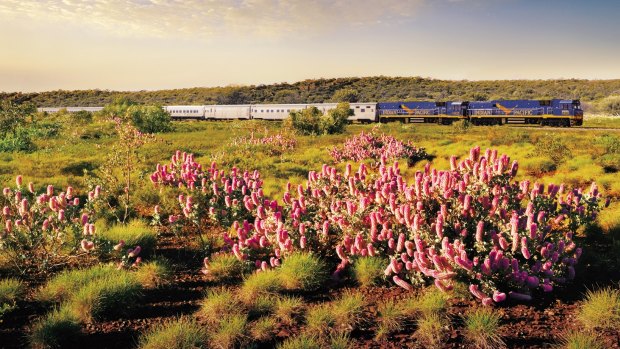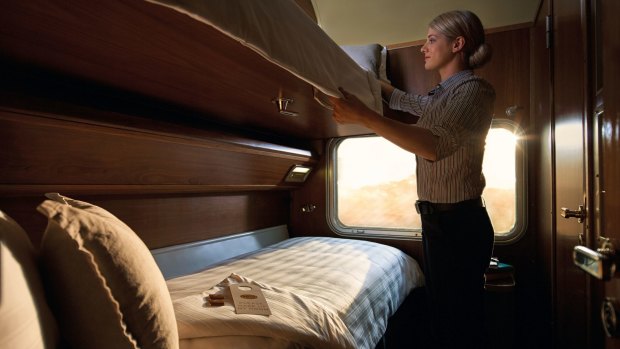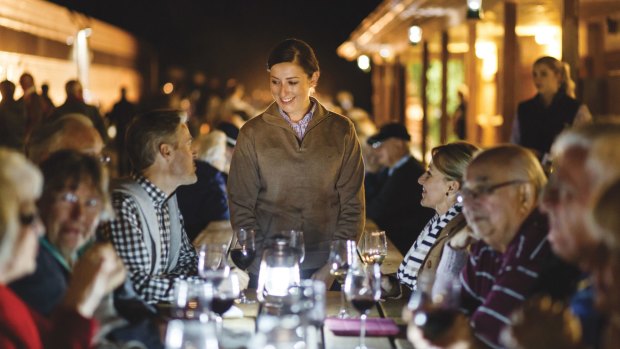This was published 5 years ago
The Indian Pacific: An epic train journey across Australia, from Perth to Sydney
By John Borthwick

The Indian Pacific.
The Nullarbor Plain is a great slab of infinity fallen to earth, a spirit-level mirage of trees and camels that probably aren't there, and crows that well may, as the locals say, fly backwards.
It is also a place of subtle fascination. Which is perhaps too easily said when you're scanning its endlessness from a train window. This rolling meditation on red earth and saltbush scrub, as accompanied by silver service dining and a private cabin, is part of the Indian Pacific train experience as it rolls us across Australia from coast to coast, if not from shore to actual shore.
The 29-carriage luxury rattler never sees the two namesake oceans that bookend our 4352-kilometre passage from East Perth Terminal to Sydney Central Station. Instead, the Indian Pacific has off-train excursions at Kalgoorlie, Adelaide, Broken Hill and the Blue Mountains.

A gold service twin cabin.
We pull out of Perth on a sunny Sunday morning while downing bubbly and canapes in the Outback Explorer Lounge car. Leichhardt and Lasseter might turn in their long-lost graves. Then it's time to explore the nooks and crannies and en-suite bathroom of the Gold Service cabin that will be my home for the next three nights and four days. A carriage attendant will later convert the lounge seat to a single bed and also prepare the upper bunk in the twin share cabins.
Lunch with friends in the discretely ornate Queen Adelaide Restaurant involves a choice between local beef, lamb or Top End barramundi. The fish is very good, and even better is the blood orange meringue tart for dessert. The winelist favours both South Australian reds and whites but I can't go past the silliest set of sibilant syllables to ever grace a Margaret River label, the Stellabella Suckfizzle Semillon Sauvignon.
A train can stir your wanderlust like a plane rarely will. Even so, budget travellers traditionally had little choice but to go by rail while their better-heeled peers could fly. Today that position has reversed: savers fly and the rich get out of town on a rail. Luxury rides like the Indian Pacific no longer even have seating cars. Many of our fellow passengers on this departure are seniors – "snowbirds', as Americans say – who are travelling not for mere point-to-point transport but a "rail cruise" experience.

Off-train dinner at Rawlinna.
At 10pm our train glides into Kalgoorlie-Boulder where in 1893 prospector Paddy Hannan demonstrated the proverbial luck of the Irish by tripping over a reef of gold. Since then they've never stopped digging in "Kal". The result is now one of town's main attractions, an open-cut abyss 3.6 kilometres long and 1.6 kilometres wide known as the Super Pit. From the lip you can usually peer down, half a vertical kilometre into the bowels of the earth and watch gargantuan haul trucks shuffling around like Matchbox toys in a sandpit.
Unfortunately for us, the observation deck is closed tonight so we attend a short, outdoors play performed by local actors, Paddy Hannan's Ounce of Luck. A quick coach circuit follows along town streets built enormously wide so a camel train could do a u-turn. A drive-by peek at ornate, glory days pubs and the "nothing-to-see-here, folks" facades of Kal's famous brothels, and we scoot back to the train for a nightcap and departure.
Overnight the Indian Pacific starts its 1200-kilometre transit of the Nullarbor Plain. This prehistoric seabed is the planet's largest limestone plate, a 200,000-square-kilometre vastness that could accommodate two Englands or four Belgiums. The Latin name means "No Tree" but the local Mirning people knew it more ominously as Oondir, "the waterless."
It's easy to eulogise the Nullarbor's furnace tundra when braving it from behind air-conditioned windows and a good gin and tonic. The explorer Edward John Eyre reckoned it to be "A hideous anomaly, a blot on the face of nature, the sort of place one gets into in bad dreams." And well he might, being the first European to make its hellish crossing, on foot, from east to west in 1841.
I hear the big loco's airhorns howl in the night and wonder what tardy 'roo or emu might have gone to meet its maker – after all, it takes 1.5 kilometres to bring this 1400-tonne leviathan to a stop. Next day the train driver, "Chris from Kal", confirms he had given a mob of wandering camels a full-blast sound and light scare to shoo them off the tracks just in time.
At dawn our 712-metre-long train glides to a gentle halt, dwarfing tiny Rawlinna where we go ashore, so to speak, for a hot breakfast and coffee on the platform, and then warm ourselves beside blazing drum fires. With 215 passengers and 35 train crew, we increase the ghost town's current population around fifty-fold.
We're travelling an old iron songline of stories, both whitefeller and black, that are all too soon forgotten. At noon, as the South Australia border flickers past un-noticed so too does Deakin, a whistle-stop in the mulga named for Australia's second prime minister, Alfred Deakin. Along with Aboriginal names there are five blink-and-you-miss-it dots along the line honouring our early PMs – Barton, Hughes, Cook, Curtin and Chifley. Appropriately, the latter pair, Labor men, sit farthest left on the transcontinental line.
The fading name of Australia's sixth prime minister, Sir Joseph Cook, hangs on at our next ghost town 1500 kilometres east of Perth, once home to 200 people. While the Indian Pacific takes a breather we explore Cook's curious features, notably the old wooden lock-up booth that squats beside the platform looking like a Ned Kelly Tardis.
"A very fine pencil line across the desert," astronaut Andy Thomas said when he saw the transcontinental rail from outer space. We're now on the 478-kilometre section that is the longest, straight stretch of track in the world, a ley-line filament spanning the sort of landscape that Africans know as "Mamoba" – miles and miles of bugger-all.
Time passes with more good meals and wines (all included in the fare, as are the excursions) in the restaurant car, although there seems a surprising absence of kangaroo on the menu. Travis, the train's young, on-board troubadour pops up from time to time to do acoustic sets, including a good take on Cold Chisel's poignant Flame Trees. I alternate between reading, conversing and contemplating the Never-Never.
On the second night we boom through briefly-famous Tarcoola, a hiccup of bricks and tin and probably one brown dog. Some 1970 kilometres from Perth and 700 kilometres from Adelaide, Tarcoola was named after – what else? – the horse that won the 1893 Melbourne Cup. Our transcontinental track intersects here with the Central Australian line that turns north to Alice Springs and Darwin, carrying the Indian Pacific's sister service, The Ghan, also operated by Great Southern Rail.
Early morning finds us at Adelaide Terminal, our cruise train's "home port", with excursion coaches waiting. I skip the gourmet delights of the Central Markets and opt for a tour of Adelaide Oval, considered one of the most beautiful cricket grounds in the world. I'm 180-degrees away from being a cricket tragic but a visit to the innards of the sacred ground's heritage-listed scoreboard is an unexpected thrill. It remains all-manual, non-electronic and in use throughout the year, as it has been since 1911.
As we trundle north again, past quilted vineyards and wheat fields, people in the lounge car keep huffing at their phones. The train has limited phone Wi-Fi access, especially when crossing the Outback's signature, "one bandicoot per acre" stretches. Welcome to Mamoba.
"Hell, west and crooked," is how a woman once lovingly described to me the landscape surrounding her hometown, Broken Hill. The flamboyant desert rivals the costumes in the movie The Adventures of Priscilla, Queen of the Desert, filmed in these parts in 1994. "The Hill", previously a macho to the max town, has been trading on its drag cred ever since. And so we stroll from the station to the grand and mural-festooned Palace Hotel, heartland of "Broken Heel" culture, where a pair of big, boofy blokes in boas are camping it up. Mid-song (Abba, of course), their lip-glossed, lip-synched performance is punctuated quite literally by the really big one stabbing his not-so-delicate stiletto heel right through a floorboard. Mandatory shrieks all round.
The Indian Pacific, its top-class dining and cruise-style excursions notwithstanding, still runs on good old, standard-gauge, Aussie rails, as opposed to floating like a ballistic butterfly. A Maglev bullet train might blur past at 600km/h but our trusty iron rooster settles for 115km/h. Having to step aside often for non-stop freightliners, it averages a respectable 85 km/h across the long journey. As an old-time Territorian on The Ghan reckoned to me years ago about warp-speed trains: "Who needs to go that fast? I'd hate to arrive before I've left."
The New South Wales tracks provide so much bounce on our final night that I'm nudged awake early as we rumble through Bathurst at dawn. The payoff is that I get to watch from my bed as sunrise lights up the Great Divide, showing ridge-tops alive with silhouetted trees while down in the hollows statue-still cattle wait for the sun's first rays to thaw them.
Sydney approaches. But first, one more optional excursion, the Blue Mountains. We farewell our flash rattler at Mount Victoria and as it rolls on towards the Pacific, we are already riding different rails, near-vertical ones. A trio of snakes-and-ladders conveyances at Katoomba's Scenic World see us dropping at 52 vertiginous degrees to the Jamison Valley 450 metres below, and then re-ascending on a cableway before gliding high above the ancient forest in a cable car.
Nearby, the Three Sisters are being mobbed by a thousand visitors. We head to Katoomba platform for our trip finale, the curious contrast of riding down to Central Station aboard a chartered Sydney rattler. A fitting re-entry to Big Smoke reality.
TRIP NOTES
MORE
TOUR
The Indian Pacific departs Perth on Sunday and Sydney on Wednesday, year-round, for the three-night journey via Adelaide. Advance purchase, full-journey, single cabin fares start from $1799 (all-inclusive) in Gold Service class; or $619 Sydney to Adelaide. Concessions available. See railplus.com.au
STAY
The Sebel East Perth (60 Royal Street), located in a tranquil riverside enclave is an ideal start or end to the train adventure. See thesebel.com
John Borthwick was the guest of Rail Plus, Great Southern Rail and The Sebel East Perth
FIVE MORE EPIC TRAINS TO CATCH
THE GHAN
Australia's other great train, the legendary Ghan no longer lurches across the South Australian desert on flood-battered tracks. On newer rails the 2980-kilometre transcontinental journey from Adelaide to Darwin takes three days, with excursions at Coober Pedy, the Alice and beautiful Nitmiluk Gorge.
EASTERN & ORIENTAL EXPRESS
The E&O Express that rocks between Singapore and Bangkok is a post-colonial bubble and rolling work of art. To stand at its caboose-with-a-view rear car and watch the tracks and Asia slip away, green, templed or ever changing, is one of the finest perspectives anywhere in the world of rails.
ROCKY MOUNTAINEER
Your head spins constantly when riding a glass-domed GoldLeaf car aboard Canada's celebrated Rocky Mountaineer. Gliding between alpine peaks, pine forests, rivers and lakes, the brilliant, two-day, westwards journey runs from Banff to Vancouver, with an add-on option down to Seattle, Washington.
BERNINA RAILWAY
The Swiss alpine canton of Graubünden is home to both the Glacier Express, proudly billed as "the slowest express train in the world", and UNESCO-listed Bernina Railway that crosses astonishing viaducts like the 65-metre-high Landvasser span. You can do the Glacier Express by itself or as part of a 10-day Grand Train Tour of Switzerland.
LITTLE LOCOS THAT COULD
Not all great trains run on champagne. Cambodia's Phnom Penh to Sihanoukville service is back on the rails after more than a decade. Each weekend its well-refurbished carriages roll from the capital down to the old Cambodian Riviera outposts of Kampot, Kep and "Snookyville". More: royal-railway.com. Meanwhile, another remnant of empire, the Darjeeling Himalayan Railway, aka "the toy train", still zigzags its way up the hills from New Jalpaiguri, West Bengal. Its blue, World Heritage-listed steam loco, circa-1900, was surely the prototype for Thomas the Tank Engine.
See railplus.com.au and irctc.co.in
See also: What it's really like on board the Ghan train through the outback
See also: Ten of the world's most incredible luxury train trips
Sign up for the Traveller Deals newsletter
Get exclusive travel deals delivered straight to your inbox. Sign up now.